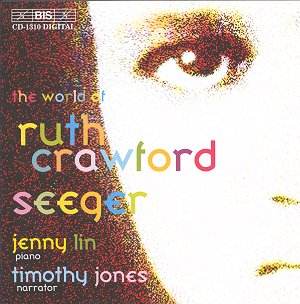I first came across Crawford Seeger’s music on an old
Nonesuch LP which coupled her String Quartet (1931) with quartets by
George Perle and Milton Babbitt. Her quartet is an impressive piece
by an impressive lady, a composer who developed a clear, individual
voice.
Taiwanese pianist Jenny Lin provides a useful survey
of Crawford Seeger’s output for piano. This disc is every bit as fascinating
as her previous solo disc for BIS, Chinoiserie (BIS CD1110).
As the booklet notes point out, one can hear Crawford Seeger’s preternaturally
rapid development as a composer just by listening to the earlier tracks
on the disc: the title of the first, Little Waltz (1922), is
not kidding. It is harmless and completely unobjectionable; similarly,
Little Lullaby and Jumping the rope (Playtime) (both undated,
but both clearly early) are charming. Little Lullaby has a music-box
quality about it, while Jumping the rope is simply great fun.
The pieces up to the Sonata are all a delight (Mrs Crow and Miss
Wren go for a Walk gets a clean, witty performance and is all the
more effective for it).
The six-minute Piano Sonata of 1923 still shows Crawford
Seeger’s Romantic sensibilities, and is blessed with an arresting ff
octaves opening gesture. This piece is just one year on from the unpretentious
miniatures that opened the disc, yet already one can sense Crawford
Seeger’s imagination expanding at a rate of knots. Lin plays it with
utter conviction. She commendably refuses to over-sentimentalise and
the piece grows in integrity because of this. The way Lin melts into
the 1923 Theme and Variations is most affecting: here is seven
minutes of pure delight, which also contains glimpses of Crawford Seeger
letting her hair down and being determinedly and outrageously ‘popular’.
Listening to the Five Canons (1924) and the Kaleidoscopic
Changes on an Original Theme (also 1924), one can hear Crawford
Seeger’s compositional confidence growing. The canons are but fleeting
glimpses (the longest is 1’31, the shortest 26 seconds); Kaleidoscopic
Changes seems an apt title rather than ‘Variations’ as there is
indeed great variety, from the spiky first variation to the lovely ‘warm’
harmonies which Crawford Seeger sometimes elects to use.
The Preludes of 1924-28 (in two groups: Five
Preludes of 1924/5 and Four Preludes of 1927/8), along with
the Piano Study in Mixed Accents reveals Crawford Seeger moving
up an avant-garde gear. There is real daring here and one can almost
feel the sense of discovery. The Five Preludes begin in a decidedly
Schoenbergian fashion and remain in this more modern world. The second
is distinguished by compositional impetuosity; the third and fifth by
their desolate and bleak moods and textures. Similarly, Bartók
makes his influence known in Prelude No. 8 (i.e. the third of the Four
Preludes of 1927/8), whilst the slow and hypnotic No. 9 rises from
the depths of Debussy’s submerged cathedral.
The Piano Study in Mixed Accents (1930) is given
here in three performing versions,
each dynamically distinct. It is a very difficult piece
and in Lin’s hands every note is clear. Her third version is positively
volcanic. In the case of this piece, there have been alternative versions,
although none as thoroughly contextualised as this: Alan Feinberg made
a recording on a disc called The US Innovator (Argo 436 925-2),
while Reinbert de Leeuw played one version on Portrait of Ruth Crawford
Seeger (DG 449 925-2).
Presumably for the sake of completeness We dance
together is included, a delightful waltz used for teaching purposes.
Finally, there is The Adventures of Tom Thumb for narrator and
piano (1925). Timothy Jones is witty in describing the adventures and
Lin plays characterfully, but the value of this disc lies in the solo
works. Very strongly recommended.
Colin Clarke


